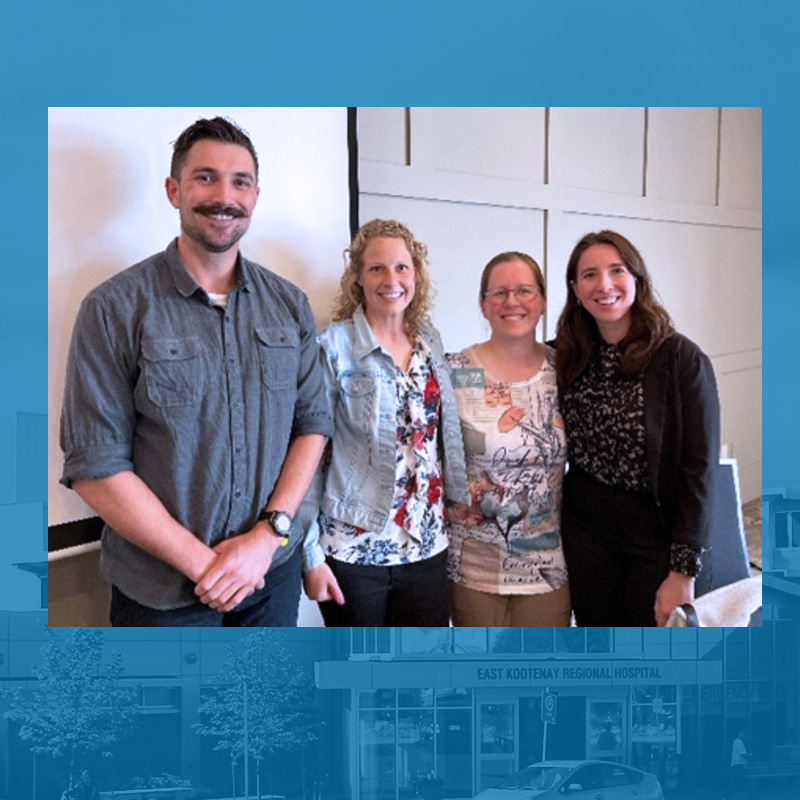
| Photo: (L to R) Clayton Bell – Clinical Operations Manager (Access and Flow), Dr Elena Schroeder – EKRH Hospitalist, Head of Department of Hospitalists, Dr Katherine Wight – Cranbrook Family Physician and Head of Department of Family Practice, Nikky Love – Clinical Operations Manager (Access and Transitions) |
“It was different because we work so closely together, we see each other every day so the relationship was already partially there. It wasn’t about talking to the higher-ups and asking for more resources, but about actually trying to solve a problem on the ground together.” – Dr Katherine Wight
Exploring process challenges and improvements
Drs Katherine Wight and Elena Schroeder were experiencing significant challenges to discharging patients efficiently at East Kootenay Regional Hospital.
They found the process often required discussions with multiple providers and staff, especially for patients without a family doctor, those experiencing socio-economic difficulties, and/or those with complex care needs.
At the time, conversations were happening between Hospitalists/Family Physicians and discharge planning, Home Care, the Transition Liaison, Occupational Therapy, Physiotherapy, and family members.
The process was unclear, inefficient, disjointed, and time-consuming, especially when it came to handover between hospitalists. This often led to confusion for the family and patient, as well as delays due to miscommunication.
They knew there had to be a better way and began to brainstorm ideas for improvement.
Drs Wight and Schroeder used the support of SSC Facility Engagement MSA funding to discuss the issues with various providers, brainstorm solutions to streamline the discharge process, and engage physicians and health care teams in implementing changes.
Solutions include:
- Working with the Patient Care Coordinator (PCC) to become the point person for communication between the health care teams and physicians, which included clarifying their job description, putting new processes in place, and discussing how best to utilize the role for discharge planning.
- Increasing physician understanding of how patients are approved, processed, and discharged to Long Term Care, Short Stay Beds, or home, including the timing of these processes, and how to prepare anticipated discharges in advance.
- Knowledge-sharing about employee roles in the discharge process for acute and community care, i.e. “who is who and what do they do”.
- Explaining and socializing the new process with physicians and other health care teams through a dinner event and short presentation.
Reflecting on the EKRH Overcapacity Project from 2019, which included a long consultation process and the development of several recommendations by an external consultant, Drs Wight and Schroeder commented that things have changed significantly since then.
While having the foundational document was helpful to find out who had participated and what their position was, almost none of the recommendations applied to the current environment.
Key success factors
- The willingness of the teams to talk openly about issues and co-develop solutions.
- Gaining a deeper understanding of the operational processes and employee roles within patient discharge planning.
- Strong leadership to move the work forward.
The shift since 2019 showed that positive change can be a matter of timing and having the right people in place.
Impacts
- A deeper understanding from physicians of access and flow and hospital discharge processes from the non-physician perspective, helping to develop solutions that worked for everyone.
- Improved relationships through sharing the same challenges and truly wanting to understand the different perspectives, struggles, and ideas for improvement.
- Improved lines of communication through understanding employee roles and responsibilities related to discharge planning, and the development of visual process documents.
- 19 physicians and 9 health authority staff engaged.
Key takeaways and lessons learned
- Drs Wight and Schroeder noted that it took time for everyone to understand how to share information through the PCC, but having an event to bring people to together to socialize the changes was very helpful.
- FE project manager, Jill Bain, highlighted that engagement is not always about paying people for their time, if you hit the right topic – people will show up and get involved.
- The project team reflected on how "if you don’t engage with people who are experiencing the problem, you won’t get the buy in needed to change."
- In addition, existing relationships between providers and health authority staff made working together to solve a common problem easier and more effective.
- Lastly, if one-pagers / process documents are going to be effective and changes sustained, they need to be simple, visually compelling, and easily accessible (i.e. mobile-friendly).
“You can do the top-down approach, get consultants, recommend things that need to change, but if you don’t engage key people on the ground, then you won’t get the buy in that is needed to be effective. It was helpful that we could sit down at a table and brainstorm with our health authority dyads, expressing the struggles each person had, with both sides feel heard and understood. We are so dependent on each other.” – Dr Elena Schroeder
Resource: For the graphic outlining the objectives of the project, roles and responsibilities in the discharge process, the PCC as point person, and preparing anticipated discharges in advance, see here.
![]()
 |
 |
 |
